There was a time, not too long ago, when having the smallest phone was a mark of prestige for handset manufacturers. Then HTC came along and convinced us that 4.3-inch smartphones are actually pretty useful, closely followed by Samsung and its current postulation that 4.5 inches might be even better. Sony Ericsson isn’t exactly resisting this trend toward ever-larger touchscreen slabs, having delivered the 4.2-inch Xperia Arc earlier this year, but it also has something to offer to lovers of pretty, little things: the Xperia Mini and Xperia Mini Pro.
The pair of Mini Android phones differ only in the fact that the Xperia Mini Pro is equipped with a slide-out keyboard, which goes a long way to justifying its rather ample thickness. Having spent the better part of two weeks using it as my regular phone, I can say that the keyboard is by far its biggest strength, but there’s plenty more here to explore: a 1GHz processor, a 5-megapixel camera with HD video capture, and all the joys of testing Android 2.3.3 on a frugal 480 x 320 screen resolution. Oh, and speaking of frugality, the Xperia Mini Pro can be had unlocked for a penny under £220 ($360) right now, which is less than half the cost of your typical Android smartphone. Click past the break to see if that represents real value for your money.
Hardware
Hardware / design
Of all the phones you’ve heard described as having a soap bar shape, the Mini Pro might be the one that adheres to that definition best. Its dimensions (92 x 53 x 18mm / 3.6 x 2.1 x 0.7 inches) seem to have come straight out of Tyler Durden’s guide to good soap making, though how suitable they are to a smartphone is debatable. In spite of being markedly narrower and shorter than its Android contemporaries, the Mini Pro’s bulkier derriere actually makes it less pocketable than the competition. Whereas an Incredible S or an Optimus Black might slip into the pocket of your tightest jeans, the Mini Pro demands quite a bit more room for comfort. Its 136-gram (4.8 ounces) weight is also a bit on the heavy side, meaning that you’ll rarely lapse into being unaware you have this phone somewhere about your body. That may be a good or a bad thing, depending on your perspective.
In terms of build materials, the Xperia Mini Pro is a highly impressive device. Nothing is particularly expensive, but the external components are well selected and put together flawlessly. Alignment between the two sliding portions of the phone is perfect and the spring-loaded slider exhibits no flexing or movement along an axis other than the one you want it moving along. The back cover is made of a satisfyingly thick soft-touch plastic, which has a bit of flexibility to it. You’ll have to work hard to leave any permanent markings on it, as it looks to be a durable and hardy shell. Opening the back of the Mini Pro is done with relative ease, and I was happy to find the microSD card slot sitting free of any battery-related impediments. That means you’ll be able to hot-swap storage cards without having to reboot the phone, a commonly underrated but occasionally invaluable feature. There’s also a nice tactile correspondence between the soft back and the keyboard’s buttons — the two surfaces have a similar texture, which really makes the handset feel like a holistic device.
The capacitive buttons work seamlessly with the touchscreen above them
A chrome frame interrupts the mostly black casing of the Mini Pro and marks the split between the two halves. The top compartment houses the 3-inch display, front-facing camera, proximity sensor, earpiece, and three (just three) Android buttons. A single glass surface covers almost the entire front; only the Home key and earpiece are separated out, with the Back and Menu keys being capacitive and sitting either side of the one physical button. Delineating the Home key in this fashion is a boon for usability, while the capacitive buttons work seamlessly with the touchscreen above them. On the whole, it’s a very well thought-out interface.
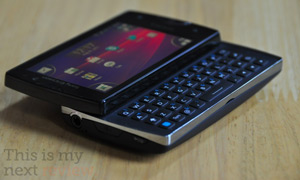
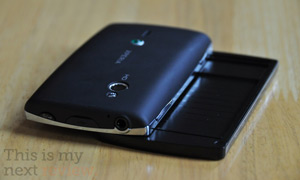
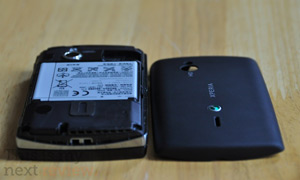
Keyboard
A sterling keyboard that can be favorably compared against pretty much anything out there

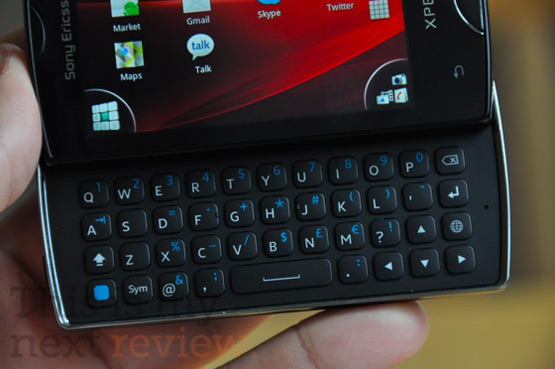
The lower half of the Mini Pro is home to the majority of the electronic goodies and the one crucial mechanical component, the keyboard. This won’t be true for everyone out there, but the Xperia Mini Pro has the best keyboard I’ve yet used on a smartphone. Layout is highly logical, key travel is sufficient, spacing is just about ideal, and the backlight is even and unintrusive. Comparing this to the pad available on the Xperia X10 Mini Pro, the forefather to the current device, you’ll find the same four rows, but the Mini Pro adds an eleventh column of keys and also improves on key positioning. The backspace button is now in the top right corner, the comma and period buttons frame the space bar, and the new room is exploited with the introduction of a four-directional keypad.
These improvements may appear slight, and the X10 Mini Pro already had a laudable keyboard, but the ultimate effect is that the Xperia Mini Pro has a sterling keyboard that can be favorably compared against pretty much anything out there. Even the roomier keypads on the likes of the myTouch 4G Slide or the Droid 3 don’t feel as natural and easy to type on. Among recent smartphones, only the Nokia E7 has a physical keyboard good enough to make me actually want to use it, but the problem with that handset was that you needed to be trained in how to open it properly. The quick and easy sliding mechanism on the Mini Pro puts the E7 and the sluggish slider that’s been the hallmark of Motorola’s Droid series to shame.
Display
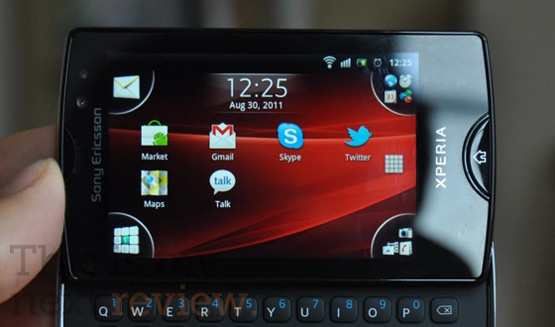
A gentle sense of luxury pervades use of the Xperia Mini Pro. This is partially owing to the sumptuous feel of the rear cover and keypad and partially thanks to the single sheet of glass up front. What might go unnoticed here is that the black monolith look that the Mini Pro goes for wouldn’t work without the extremely dark grey that the screen reverts to when switched off. It’s still grey, not a pure black, but the effect for the user is that when images are displayed, they seem to be overlayed on a touch-sensitive slate, a sensation that’s enhanced by the capacitive buttons beneath the screen. A subtle little trick, this may be, but it enhances the user experience in a universal fashion.
Once turned on, the 3-inch screen itself is somewhat underwhelming. Colors can pop out brilliantly on occasion and usability in the sunlit outdoors is above average, but viewing angles are narrow and the backlight has a tendency to overwhelm the images put in front of it. It’s hard to see why Sony Ericsson is persisting with sub-par LCDs now that pretty much every other major phone maker — HTC, LG, Samsung, Apple, and Nokia — has figured out an affordable IPS, AMOLED or Super-LCD panel to insert into its phones. The one thing every buyer will use and react to most viscerally is the display, so it doesn’t make a great deal of sense for SE to be cutting corners here. Another recurring and slightly offputting issue with Sony Ericsson phones is that the touch-sensitive layer is visible as a dotted grid atop the display when looking at it from a certain angle. You won’t notice this too often and it certainly doesn’t affect regular use, but it’s there, the very idea of it gnawing at your mind like the raven of Edgar Allan Poe’s poem.
Narrow viewing angles and an overzealous backlight spoil the fun
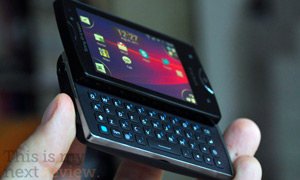
Battery life, reception, and audio
The Mini Pro is on par with the Arc and ahead of the Play in terms of battery endurance
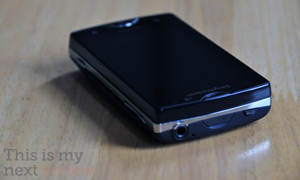
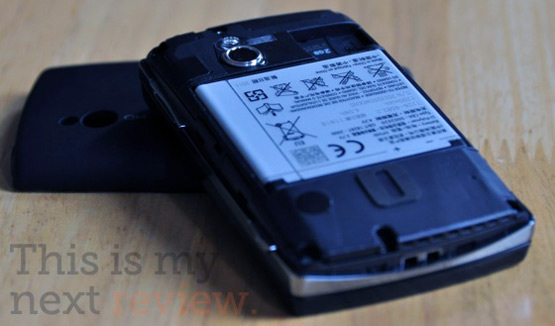
With the display being one of the major consumers of power in modern phones and the Mini Pro having a comparatively small one, you’d think this would be a handset that lasts an extra bit longer than its competition. The premise of that supposition is accurate enough, however Sony Ericsson opts for a teeny tiny 1,200mAh cell in the Mini Pro. What results is distinctly average battery life for an Android phone. In regular use, I typically got to around 28 hours between charges. That time was spent with Twitter and Gmail updates running in the background and a mix of music playback, web browsing, photography, and Maps navigation in the foreground. Relative to Sony Ericsson’s own Xperia line, the Mini Pro seems to be about on par with the Arc and ahead of the Play in terms of battery endurance.
Taking the Mini Pro around my usual London haunts, I found it had as many or more bars than most of the phones I’ve recently reviewed (Incredible S, Sensation, Galaxy S II, Xperia Arc). There were certainly no dropped or missed calls and no identifiable distortion caused by poor signal. Data rates also seemed to be on par with what I usually obtain (poor coverage in my local area and better connectivity in central London).
The earpiece is a little quiet for my tastes, though it conveys the voice of the person you’re speaking to in a natural and clear fashion. The one loudspeaker on the back provides better than average audio quality, something that’s been a Sony Ericsson strength for a long time, and should see some use for impromptu media playback. Bass tones are, as is typical for smartphones, absent without a trace. Output to headphones will still be the best and most likely method for enjoying music on the Mini Pro, and thankfully the bundled pair of ear buds is quite decent. It includes an in-line mic and play/pause control, but offers next to nothing in the way of noise isolation. Underground commuters, you have been warned.
Camera output looks excellent on the phone’s screen, but lay out those pixels on your desktop and you’ll be far less impressed. SE post-processes the living daylights out of images taken with the Mini Pro, leaving solid blocks of color reminiscent of Photoshop’s Poster Edges filter. People look like monotonal mannequins, edges and boundaries between colors are over-emphasized and subtle detail is habitually lost.
The culprit for this overzealous image manipulation is of course the fear of noise and graininess sneaking into captured images, with Sony Ericsson opting to optimize the results for viewing on the device itself instead of for the best photographic outcome. That notion is also supported by the camera’s tendency to oversaturate images. Choosing to go that route isn’t uncommon among phone makers and is to some extent understandable. What I find aggravating, however, is the labeling of this as a 5-megapixel sensor — neither the Mini Pro’s hardware capabilities nor its post-processing software justifies that title. In terms of usable imagery, you’re looking at something closer to 2 megapixels.
Video capture suffers from the same smudging effect as stills
Happier news is to be found in the performance of the camera’s software, which snaps photos almost instantly and has an intelligently designed interface. Its pair of overlaid menus slide in from the sides, a sight that should be familiar to Xperia Arc users, with the left one providing access to capture mode tweaks and the right containing previews of the last few images you’ve taken. A small notification area in the top right also informs the user when macro mode is enabled and provides alerts when lighting in your composition is too bright for the camera to handle (typically activated when shooting the sky on a sunny day).
720p video capture is one of the Mini Pro’s headline features and it does indeed work as advertised. Sadly, the video results suffer from the same smudging effect that the phone’s camera applies to still images, leaving you with a lack of fine detail at full resolution. Things don’t look much rosier when viewed through the front-facing VGA camera. Its image-capturing credentials stretch no further than fulfilling the main purpose of its presence on the phone — video calls. Taken as a whole, the Mini Pro’s photography equipment offers no threat to the finest cameras available on current Android phones, but it’ll certainly do the job for the less demanding user. It’s easy and quick to operate and does a good job of capturing video, even if detail levels aren’t up to the best standards around.



Software
Sony Ericsson squeezes a lot of utility (and some bloatware) into this 3-inch device


Android 2.3 should be an extremely familiar sight by now. The Gingerbread version of Google’s mobile OS is a relatively mild upgrade from Froyo (2.2), which in itself has been with us for over a year. I wasn’t able to find any apps for the platform that had compatibility issues with the Mini Pro’s 480 x 320 screen resolution, but there’s no guarantee that the same will be true over the long term. 800 x 480 was the de facto standard Android resolution of 2010, qHD (960 x 540) is growing into that for 2011, and current speculation is pointing toward Android phones with 720p resolution before the year’s end. No matter what compatibility improvements (like, say, Fragments) Google adds to its forthcoming Ice Cream Sandwich version of Android, the fact remains that developers will dedicate the bulk of their resources to the most popular hardware platforms — and those are rapidly moving away from the Mini Pro’s specification.
A somewhat cloudy future when it comes to app compatibility is a readily predictable aspect of this phone’s existence; you’ll want to know what it’s like to use today. Well, rather disquietingly, I managed to incite an app crash error while setting up the Mini Pro for the first time. Once I moved past that inauspicious start, however, I was greeted by a highly responsive interface that generally whizzed through its tasks. Sony Ericsson has gone to great lengths to standardize its user experience within its 2011 Android product line, so you shouldn’t be surprised to see most of the aesthetic tweaks it applied to Android on the Xperia Arc and Xperia Play present on the Xperia Mini Pro. For the most part it’s the same experience shrunken down for the form factor.
The homescreen's corners can now be turned into folders
Where the Mini Pro differs (from every smartphone other than the Xperia Mini and their collective ancestors the X10 Mini and X10 Mini Pro) is with its "corner UI" concept. The four corners of the screen function much in the same way as the typical four-icon launcher dock (such as the one on the Arc). They’re persistent wherever you are among the five homescreens and provide links to what will ideally be your four most-used applications. The 2011 Mini and Mini Pro improve on that idea by allowing you the added option of turning the corners into folders of multiple icons. Up to four apps can be stashed into each corner — with their icons visible exactly as you’d see them within iOS folders — which does a great job of making up for the Mini Pro’s limited screen real estate. Not counting the corners, you have room for 12 apps per homescreen, but if you load everything up, you’ll be a couple of taps away from no less than 28. For a 3-inch screen touting yesteryear’s resolution, that’s pretty good work.
Sony Ericsson’s efforts to offer an enhanced package of apps with the Mini Pro fall firmly within the "bloatware" category. There are game trials (Plants vs Zombies, Chuzzle, Peggle, and Brick Breaker Revolution 2), links to Vodafone’s music and app stores and Sony’s Music Unlimited app, and, most annoyingly, a couple of pieces of McAfee security software that keep popping up notifications pestering you to register. There is one helpful inclusion among the bunch, which is a straightforward data monitor utility with options for setting alerts at particular thresholds. It has a clean interface and lets you start tracking data from a given day each month, thereby directly emulating the period of your monthly data allowance.
UI animations on the Mini Pro are fluid for the most part, but they do stutter occasionally when you’re trying to do things quickly. On the plus side, Sony Ericsson has really done its homework when it comes to optimizing navigation speed, as things like the app menu and contacts list pop up with an appropriate briskness. App loading times, on the other hand, are average, bordering on slow. Both the gallery application and browser show a slight bit of lag when executing pinch-to-zoom gestures, with the former also exhibiting a noticeable delay when loading new pictures. More worryingly, the gallery app sometimes fails to properly respond to lateral swipes instructing it to move to the next image. That behavior’s unfortunately also true when the phone’s locked, with the Mini Pro failing to register my unlocking swipes on a couple of occasions. It bears noting that these issues cropped up rarely during my testing and were overcome painlessly, so I wouldn’t classify them as anything more than a nuisance.
The Mini Pro has the same 1GHz MSM8255 Snapdragon SOC and 512MB of RAM as found within the Xperia Arc and Xperia Play, so if you want a handy guide to how it feels on a day-to-day basis, those devices are definitely worth a look. Browser performance is fast and reliable, but for the aforementioned lack of perfect fluidity when pinching to zoom and scrolling. It’s only when you set the Mini Pro against the recent dual-core beasties that are the Galaxy S II and Sensation that you’ll really notice a difference in general responsiveness.
Video review
The few cutbacks Sony Ericsson has made appear reasonable and mostly peripheral
Some software glitches aside, the Xperia Mini Pro provides incredible bang for your smartphone buck. Far from the typical afterthought appendage, its keyboard offers stellar tactile feedback and a frustration-free layout. The fact that the Mini Pro costs half as much as the typical Android handset only sweetens the deal, while the few cutbacks Sony Ericsson has made appear reasonable and mostly peripheral. Power users will inevitably feel constrained by the diminutive screen size, and the rotund form factor remains somewhat questionable, but then the Mini Pro was never designed to be everything to everyone. As it stands, it’s a charmingly pudgy little handset, a more than worthy successor to the X10 Mini Pro, and one of the best budget Android phones you can buy today.
:format(webp)/cdn.vox-cdn.com/uploads/chorus_asset/file/12788561/xperiaminipro425ra.1419962237.jpg)
:format(webp)/cdn.vox-cdn.com/uploads/chorus_asset/file/12788561/xperiaminipro425ra.1419962237.jpg)
Share this story